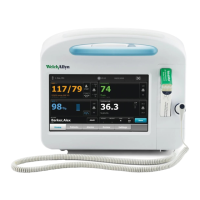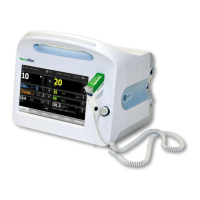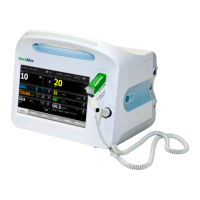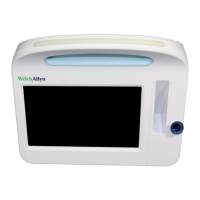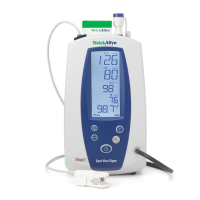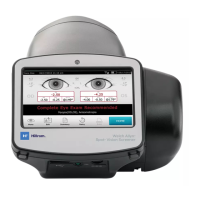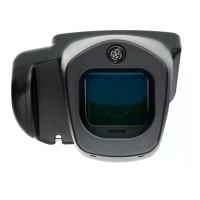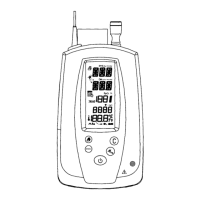




Do you have a question about the Welch Allyn Connex Spot Monitor and is the answer not in the manual?
| Battery Life | Up to 8 hours |
|---|---|
| Display | 7 inch color touchscreen |
| Connectivity | Bluetooth, USB |
| Power Source | AC power, Rechargeable battery |
| Measurements | Blood pressure, temperature, SpO2, pulse rate |
| SpO2 Technology | Masimo or Nellcor |
| Optional Features | Printer |
| Temperature Technology | SureTemp® Plus or Braun Thermoscan® Pro 6000 |
Explains warning, caution, and DFU symbols used in the manual.
Describes power button, indicators, AC power, and battery status symbols.
Explains symbols for Bluetooth, Ethernet, USB, and Nurse call connections.
Explains symbols for manufacturer, product identifier, reorder number, and disposal.
Describes the process indicator for acquiring measurements and connecting to a laptop.
Details safety risks like electrical hazards, fire, explosion, and measurement inaccuracy.
Covers using recommended accessories and authorized service personnel.
Explains ESD hazards and precautions for handling sensitive components.
Defines the manual's intent for trained service personnel and supported repair levels.
Lists other relevant manuals and websites for product information.
Lists services like telephone support, loaner equipment, and service agreements.
Explains service for products not under warranty, including training.
Outlines requirements for warranty and non-warranty repairs, including technical support.
Refers to maintenance topics like periodic checks and battery replacement.
Notes the tool's ability to support future products via plug-ins.
Details the device's batteries, charging, and status indicators.
Provides advice to extend battery life, including handling and storage.
Lists settings that impact battery life and recommended values.
Identifies LCD screen, thermometry, battery indicator, and power button.
Identifies battery compartment, NIBP, USB, Ethernet, Nurse call, and SpO2 ports.
Identifies APM battery compartment, status indicator, and light power switch.
Identifies APM printer port, USB ports, power connection, and ground lug.
Provides steps to access advanced settings using an access code.
Covers language, profile, and date/time settings.
Allows specifying NIBP and temperature settings.
Configures averaging intervals for NIBP.
Configures program intervals for NIBP.
Configures WiFi settings like ESSID and radio mode.
Configures network security like WEP and WPA.
Configures server communication methods and data encryption.
Configures Bluetooth radio settings and device name.
Configures Ethernet and IP settings.
Manages device communication address and access settings.
Displays read-only network status information.
Displays read-only WiFi or Bluetooth connection status.
Enters device identification details like asset tag and location.
Describes the power-on self-test (POST) process and error handling.
Details requirements for OEM and customer security credentials.
Lists certificate requirements for server authentication.
Explains fields within a certificate like Serial Number and Subject.
Steps to create a certificate file for WAST.
Displays the monitor's Bluetooth connection status.
Steps to enable Bluetooth pairing.
Instructions for pairing laptops with the monitor.
Steps to connect and download data via Bluetooth.
How to rename a paired laptop.
Information specific to reassembly after disassembly.
Additional instructions for installing new options or parts.
Lists tools needed for disassembly and repair.
Specifies torque values for screws during reassembly.
Describes locking, friction, and ZIF connectors used in the device.
Details the handling of flex cables and ZIF connectors.
Explains coaxial connectors, particularly for the wireless radio board.
Provides a flowchart for complete device disassembly.
Describes powering down via the power button.
Describes powering down using onscreen controls.
Notes that reassembly is the reverse of disassembly.
Lists the battery kit item and notes reassembly is reverse.
Steps to disconnect and remove the SureTemp module.
Lists the SureTemp Plus module kit item and reassembly notes.
Steps to disconnect and remove the Braun ThermoScan module.
Steps to disconnect and remove the speaker.
Instructions for guiding the speaker wire during replacement.
Steps to disconnect flex cables and lift the antenna board.
Notes that reassembly is the reverse of disassembly.
Steps to remove the SpO2 insert by unscrewing it.
Steps to disconnect the power harness and the insert.
Steps for attaching the power harness and installing a new SpO2 board.
Instructions to align and secure the power harness to the insert.
Steps to align the insert, connect tubing, and secure with screws.
Steps to remove the Masimo SpO2 board and adapter board.
Steps to remove the Nellcor SpO2 board and adapter board.
Steps to remove the Nonin SpO2 board.
Steps to remove the wireless radio board.
Steps to remove the Bluetooth board.
Notes about reassembling the LCD and using Gaff tape.
Steps to insert the LCD flex cable into the connector.
Instructions for applying Gaff tape to secure the ferrite.
Steps to insert the touchscreen flex cable and secure the LCD.
Lists the pump assembly kit item and reassembly notes.
Instructions to place and secure the pump manifold.
Steps to lift the bezel and feed the power switch cable.
Notes about reassembling the bezel.
Steps to peel off the button and unthread the flex.
Steps to clean, remove liner, and thread the flex.
Steps to insert and secure the power switch.
Steps to remove screws and lift the APM work surface.
Instructions to screw and slide the APM work surface.
Steps to loosen screw, remove door, and lift battery.
Steps to remove screws and pull the power supply down.
Notes limitations on parts availability for service personnel.
Explains where to find the model and serial number on the back housing.
Describes service kits for devices manufactured from 2019 onwards.
Lists service kits by number, material, and description.
Describes service kits for devices manufactured 2015-2018.
Steps to take if liquids spill on the monitor.
Lists approved and not approved cleaning agents.
Detailed steps for cleaning liquid spills.
Procedures for cleaning all exposed surfaces of the device.
Instructions for air-drying components and wiping the screen.
Guidelines for storing the device clean and dry.
Cleaning instructions for accessories like cuffs and sensors.
How to clean contacts on the thermometer and dock.
Procedures for decontaminating devices before return.
Explains configuration files and their application.
Steps to edit a saved configuration file via the Configuration Tool.
Steps to copy an existing configuration file.
Steps to download configuration files for deployment.
Guide to creating new configuration files using the Configuration Tool.
Steps to load configuration files onto devices from a USB drive.
Explains the purpose of tests and the use of the service tool.
Details the service tool editions and their capabilities.
Lists tests performed by the standard unlicensed edition.
Lists tests performed by the Gold edition service tool.
Steps for performing NIBP accuracy checks manually.
Details the ground stud and its mating connector for safety testing.
Introduces basic functional verification checks.
Explains calibration availability and support for routine maintenance.
Lists tools used for basic device functionality checks.
Diagrams and lists equipment for NIBP leak, overpressure, and accuracy tests.
Describes the automatic NIBP leak test procedure.
Details the NIBP overpressure test procedure.
Manual NIBP accuracy check using service tool.
Steps for NIBP accuracy test without the service tool.
Procedures for testing the device's SpO2 function.
Instructions for connecting test equipment for thermometry.
Tests the SureTemp system using a calibration key.
Guidelines for setting up the calibration tester.
How to scroll and change set points on the tester.
Steps to test SureTemp probe and system in Direct mode.
Explains functional verification for Braun thermometer with tester.
Clarifies that Braun ThermoScan software is not field upgradable.
Firewall settings for service tool updates.
Information on obtaining and installing software upgrades.
Table showing options available for different models.
General advice before installing options, including functional testing.
Explains interaction between monitor and service tool for upgrades.
Steps to roll back to previous firmware versions.
Lists comprehensive partnership program agreements.
Lists biomed partnership program agreements.
Lists warranty extension support agreements.
Information on training required for Gold edition service tool.
Details physical specifications like dimensions, electrical rating, and protection classifications.
Lists weight, display resolution, and speaker volume specs.
Details display dimensions, resolution, and pixel size.
Specifies output sound pressure and tone characteristics.
Lists requirements for USB flash drives and recommended models.
Details radio specifications like frequency bands and channels.
Lists regulatory approvals for US, Europe, and Canada.
Lists supported network protocols like UDP, DHCP, TCP/IP.
Details Bluetooth module features like frequency and data rates.
Details physical specifications like dimensions, electrical rating, and protection classifications.
Lists requirements for USB flash drives and recommended models.
Details radio specifications like frequency bands and channels.
Lists default settings for configuration, location, and display.
Lists default settings for date, time, and patient data management.
Lists default settings for alarm volume and priority.
Lists default settings for patient and clinician identification.
Lists default NIBP settings like systolic upper limit.
Lists default advanced NIBP settings like default view and tube type.
Lists default interval settings for automatic modes.
Lists default SpO2 settings for upper and lower limits.
Lists default temperature settings and advanced options.
Lists default manual parameter settings.
Lists default network settings for ESSID, radio mode, and security.
Lists default Bluetooth settings for MAC address and pairing.
Explains how to parse and interpret error log messages.
Steps to save log files to a USB flash drive.
Steps to access and analyze log files from a USB drive.
Troubleshooting for power-up, touchscreen, and alarm issues.
Troubleshooting for Bluetooth connection issues.
Troubleshooting for wireless network connectivity.
Troubleshooting for Ethernet connectivity to the network.
Troubleshooting for inaccurate NIBP readings and cuff issues.
Troubleshooting for NIBP module calibration and leaks.
Troubleshooting for temperature measurement inaccuracies.
Troubleshooting for SpO2 measurement issues.
Lists general SpO2 messages and their causes/actions.
Lists Masimo-specific SpO2 messages and troubleshooting.
Lists NIBP messages, possible causes, and suggested actions.
Lists SpO2 messages and their troubleshooting steps.
Addresses various SpO2 reboot errors and their causes.
Lists temperature messages, causes, and suggested actions.
Details SureTemp-specific temperature messages and troubleshooting.
Lists various temperature module functional errors and solutions.
Continues listing temperature module functional errors and solutions.
Lists various radio errors and their troubleshooting steps.
Covers invalid radio configurations and re-configuration steps.
Addresses Bluetooth connection failures and troubleshooting.
Lists APM functional errors and suggested actions.
Lists tools for functional checks, calibration, service, and maintenance.
Lists general test equipment like service box and PC.
Lists tools required for NIBP testing.
Lists tools for SpO2 configuration testing.
Lists tools for SureTemp Plus configuration testing.
Lists tools for Braun ThermoScan configuration testing.
Lists basic tools like screwdrivers and hex keys.
Explains how model numbers are constructed from options.
